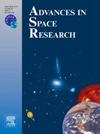Efficient area coverage planning using approximation tiling heuristics for mosaic imaging with agile spacecraft
IF 2.8
3区 地球科学
Q2 ASTRONOMY & ASTROPHYSICS
引用次数: 0
Abstract
This work focuses on the Area Coverage Planning Problem (ACPP) for optical cameras onboard agile spacecraft in space exploration missions. The objective is to determine the optimal observation path of the camera’s boresight to obtain a mosaic that fully covers a designated Region Of Interest (ROI) on the target’s surface, while considering activity makespan and computational demand. To tackle this problem, four improved heuristics are implemented, each addressing differently the need to create an acquisition plan that dynamically adjusts to the camera’s observation geometry over time. Based on the proposal from a previous study, these heuristics have been further refined to correct spatial distortion and improve computational efficiency. In consequence, the current implementation allows for application to non-convex, irregularly shaped celestial bodies. We have developed a comprehensive program framework with supporting functions and assets to enable the iterative execution of the applied heuristics under diverse observation geometries along the spacecraft’s trajectory, ensuring their robustness and adaptability.
The ACPP is a component of a broader scheduling problem for agile spacecraft, which aims to maximize the scientific return while adhering to geometric and operational constraints imposed by both the spacecraft and its payload. In this context, deterministic step-stare algorithms are preferred for their efficiency in balancing accuracy and computational resources.
The algorithms are showcased through the simulation of observations from Galileo during one of its flybies over Europa. Arbitrary and diverse ROIs are considered on the target’s surface, allowing for a comprehensive evaluation of the algorithms in different observation geometries. The outcomes are analyzed over coverage completeness, efficient planning and computational burden. Thus, the resulting mosaics provide insights into the optimal usage of the heuristics in specific circumstances.

求助全文
约1分钟内获得全文
求助全文
来源期刊

Advances in Space Research
地学天文-地球科学综合
CiteScore
5.20
自引率
11.50%
发文量
800
审稿时长
5.8 months
期刊介绍:
The COSPAR publication Advances in Space Research (ASR) is an open journal covering all areas of space research including: space studies of the Earth''s surface, meteorology, climate, the Earth-Moon system, planets and small bodies of the solar system, upper atmospheres, ionospheres and magnetospheres of the Earth and planets including reference atmospheres, space plasmas in the solar system, astrophysics from space, materials sciences in space, fundamental physics in space, space debris, space weather, Earth observations of space phenomena, etc.
NB: Please note that manuscripts related to life sciences as related to space are no more accepted for submission to Advances in Space Research. Such manuscripts should now be submitted to the new COSPAR Journal Life Sciences in Space Research (LSSR).
All submissions are reviewed by two scientists in the field. COSPAR is an interdisciplinary scientific organization concerned with the progress of space research on an international scale. Operating under the rules of ICSU, COSPAR ignores political considerations and considers all questions solely from the scientific viewpoint.
 求助内容:
求助内容: 应助结果提醒方式:
应助结果提醒方式:


